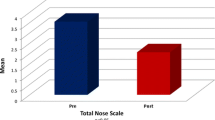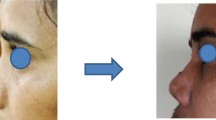Abstract
To evaluate outcome of Septorhinoplasty in Deviated nose deformity using Nasal Obstruction Symptom Evaluation (NOSE) scale and Rhinoplasty outcome evaluation score (ROE). This observational study was conducted in the department of Otorhinolaryngology and Head and Neck Surgery of KLE University’s Jawaharlal Nehru Medical College and KLES Dr. Prabhakar Kore Hospital and Medical Research Center, Belagavi from January 2015 to December 2015. Forty patients were evaluated and comparisons were made for NOSE score preoperatively and postoperatively. Comparison of decrease in NOSE score with age distribution, sex distribution, type of septorhinoplasty, ROE score of patients and ROE score of surgeons were also made. ROE score of patients and ROE score of surgeons were correlated. Their statistical significance (p value) and Cohen’s kappa (k) were calculated. Out of 40 patients, there were total of 16 Open Septorhinoplasty cases and 24 Close septorhinoplasty cases. NOSE score preoperatively and postoperatively showed statistically significant i.e., total score (p = 0.001). ROE score of patients and surgeons had poor correlation (k = 0.1; p = 0.2). Decrease in NOSE score postoperatively with ROE score of patients showed statistically significant (p = 0.01). There was no significance on comparison of decrease in NOSE score postoperatively with ROE score of surgeons (p = 0.09), age distribution (p = 0.1), sex distribution (p = 0.2) and septorhinoplasty (open/close) (p = 0.2). The outcome of septorhinoplasty has been validated with NOSE scale and ROE score and has been proven that there is improvement in nasal obstruction and quality of life after septorhinoplasty. The quality of life scoring is essential for patients subjected to septorhinoplasty for assessing success of the surgery.



Similar content being viewed by others
References
Sood VP (2013) Corrective rhinoplasty, 3rd edn. CBC, New Delhi, pp 1–8
Tardy ME (1997) Rhinoplastty: the art and the science. Saunders Elsiever, Philadelphia, pp 1–15
Sam A, Deshmukh PT, Patil C, Jain S, Patil R (2012) Nasal septal deviation and external nasal deformity: a correlative study of 100 cases. Indian J Otolaryngol Head Neck Surg 64(4):312–318
Stewart EJ, Witsell DL, Smith TL, Weaver EM, Yueh B, Hannley MT (2004) Development and validation of nasal obstruction symptom evaluation (NOSE) scale. Otolaryngol Head Neck Surg 130:157–163
Alsarraf R, Larrabee WF, Anderson S et al (2001) Measuring cosmetic facial plastic surgery outcomes: a pilot study. Arch Facial Plast Surg 3:198–201
Rohrich RJ, Ahmad J (2011) Rhinoplasty. Plast Reconstr Surg 128(2):49–73
Jang YJ, Moon BJ (2012) State of the art in augmentation rhinoplasty: implant or graft? Curr Opin Otolaryngol Head Neck Surg 20(4):280–286
Champaneria MC, Workman AD, Gupta SC (2014) Sushruta father of plastic surgery. Ann Plast Surg 73(1):2–7
Arima LM, Velasco LC, Tiago RSL (2011) Crooked nose: outcome evaluation in rhinoplasty. Braz J Otorhinolaryngol 77(4):509–515
Most SP (2006) Analysis of outcomes after functional rhinoplasty using a disease-specific quality-of-life instrument. Arch facial plast surg 8:306–309
Hosseini MS, Sadeghi M, Saedi B, Safavi A, Hedaiati GR (2012) Aesthetic and functional outcomes of open versus closed septorhinoplasty in deviated nose deformity. Int J Otolaryngol Head Neck Surg 1(2):7–13
Won TB, Park KT, Moon SJ, Moon IJ, Wee JH, Moss T et al (2013) The effect of septorhinoplasty on quality of life and nasal function in Asians. Ann Plast Surg 71:40–44
Acknowledgements
I would like to express my special thanks to Prof. Dr. N D Zingade, Department of ENT and Head and Neck Surgery, belagavi; Prof. Dr. K. M. Keluskar, M. D. S., Professor and Head, Department of Orthodontics and all professors and teachers of Department of ENT and Head and Neck Surgery, JNMC, belagavi.
Author information
Authors and Affiliations
Corresponding author
Ethics declarations
Conflict of interest
All authors declare that they have no conflict of interest.
Ethical Approval
All procedures performed in studies involving human participants were in accordance with the ethical standards of the institutional and/or national research committee and with the 1964 Helsinki declaration and its later amendments or comparable ethical standards.
Human and Animal Rights
This article does not contain any studies with animals performed by any of the authors.
Informed Consent
“Informed consent was obtained from all individual participants included in the study.” “Additional informed consent was obtained from all individual participants for whom identifying information is included in this article”.
Rights and permissions
About this article
Cite this article
Kalakuntla, M., Patil, P.H., Belaldavar, B.P. et al. Outcome of Septorhinoplasty in Deviated Nose Deformity: One Year Cross-Sectional Study. Indian J Otolaryngol Head Neck Surg 71 (Suppl 3), 1953–1956 (2019). https://doi.org/10.1007/s12070-018-1380-x
Received:
Accepted:
Published:
Issue Date:
DOI: https://doi.org/10.1007/s12070-018-1380-x




